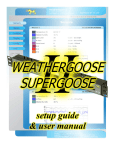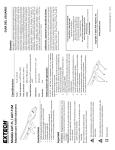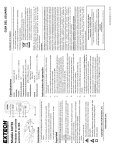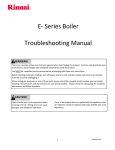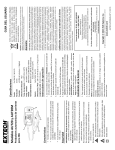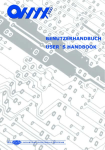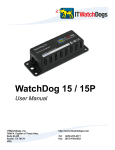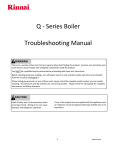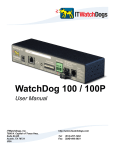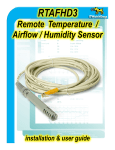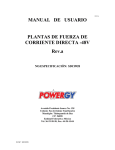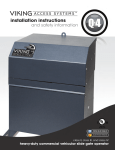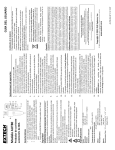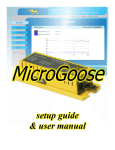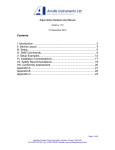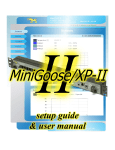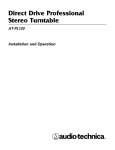Download CCAT interface (rev A-101).ppp
Transcript
CCAT Analog-to-Digital Sensor Interface installation & user guide CCAT Analog-to-Digital Sensor Interface Most models of the WeatherGoose climate-monitoring systems provide at least three Analog Inputs for use with sensors such as current transformers, water sensors, smoke alarms, or other types of sensors whose outputs are a simple dry-contact closure, a variable resistance, or a proportional 0-5Vdc signal voltage. Some models, such as the RelayGoose-II, provide as many as six such inputs. Sometimes, however, this simply isn’t enough for a particular application – especially applications which involve multiple sensors that generate actual voltage signals, such as the RCP2-100 City Power Monitor or the CT30-60-120 Current Transformer, since these devices cannot be “doubled up”, i.e. connected either in series or parallel to allow more than one sensor to share a single input. (Whereas dry-contact sensors, such as the MS-1 Magnetic Door Switch, can be connected this way, subject to certain restrictions.) For these kinds of applications, one or more CCAT Analog-to-Digital Sensor Interfaces can be used to expand the number of analog inputs, and thus the number of analog sensors. CCATs can also make some types of analog sensors easier to use. Since a CCAT can be specifically programmed to match the type of analog sensor connected to it, it can interpret the sensor’s conductivity or voltage signal into the proper human-readable scale and measurement units, instead of simply providing a generic reading of 0 ~ 99 the way a WeatherGoose’s built-in analog inputs do. Finally, the CCAT is essential for attaching these types of sensors to models such as the MiniGoose, which do not provide any built-in analog inputs. The CCAT is compatible with all models of the WeatherGoose system which provide at least one Digital Sensor Bus connection for external sensors. (Thus, it is not compatible with the MicroGoose unit, which does not have any connections for external digital sensors.) It is not compatible with the WeatherDuck, which is a legacy product which is no longer actively sold or supported by ITWatchDogs. Note: the CCAT has been manufactured in two different physical variations over the lifetime of the product. If yours does not look like the Revision B version pictured below, please consult Appendix A for information about the previous Rev.A model. (Regardless of revision, the two versions function the same way.) Also note: on most WeatherGoose models, there is a 600 ft. limit on the total length of Digital Sensor Bus cabling. The analog wiring from the CCAT’s input terminals to the sensor(s) themselves does not count against this 600 ft. limit! For example, if you had two CCATs with 12-foot data cables attached to a single unit, each connected to a WD-100 (water sensor with a 100 ft. cable), your “total cable length” for the Digital Sensor Bus would only be 24 ft. (12+12), not 224 ft. (12+12+100+100). However, we do still recommend trimming any excess wire lengths, to keep excessively long runs from acting as antennas that could pick up ambient EM interference and introduce noise or inaccuracies into the sensor readings. current (Rev.B) CCAT CCAT analog-to-digital sensor interface users’ guide – Rev. A-101 (Nov. 2010) Connecting a CCAT Analog-to-Digital Interface is fairly simple. Each CCAT is equipped with a 6p6c modular plug (also sometimes referred to as an “RJ-11” plug, since it’s the same style of plug used in US-style telephone systems) which fits into a corresponding Digital Sensor Bus socket on a WeatherGoose climate monitoring unit. A WeatherGoose will have anywhere from one to sixteen of these sockets, depending on the model in question; in addition, a splitter may be used to expand the number of available ports, up to the system’s maximum of 16 Digital Sensor Bus devices. The diagrams below provide a general illustration of how to connect a CCAT device to a WeatherGoose monitoring unit and to a variety of sensors. BK RD (Note: unless specified otherwise, the examples which follow will be shown using one or more CCATDIGITAL “generic digital” devices connected to a WeatherGoose-II unit. Any differences between other types of CCAT or WeatherGoose models will be highlighted as necessary.) modular plug at the end of the CCAT data cable fits into one of the corresponding jacks on the WeatherGoose monitoring unit As you connect each CCAT to the WeatherGoose, it will appear in the unit’s web interface where you can examine the current readings, look at the graphed history (if any), and set alarm thresholds. In the example shown here, we see a WeatherGoose-II unit with two CCAT-DIGITAL devices connected. (The CCATDIGITAL is the “generic digital” model, designed for use with any arbitrary dry-contact switch or relay, and is the model we will use for most of the following examples unless specifically indicated otherwise.) Notice that when they are first connected to the unit, both of them are named “Digital Sensor”, which is the default name for a CCAT-DIGITAL device. The only way to distinguish them is by their device ID numbers, which are shown in the right-hand side of the title bar for each sensor block, as highlighted here. For this reason, when connecting multiple CCAT devices for the first time, we recommend that you only connect one CCAT at a time, wait for it to appear in the Sensors page, then make a note of its ID number and, if desired, change its name to a more meaningful one via the “friendly names” settings on the Display tab. (We will touch on this briefly in a moment; or you may refer to the user manual for your particular WeatherGoose model for more detailed instructions.) You may also wish to use a fine-point marker or a stick-on label to mark the device ID and friendly name on the cable and/or the plastic housing, to assist you in identifying each device during or after installation. Then, after you have identified and marked the first CCAT device, connect the next one in turn, and repeat this procedure until all CCATs have been connected and properly identified. Here, we see the Display page with the two CCATs connected. Notice that there are three entries under “Devices”; the first one, at the top of the list with a device type of “climate”, is the WeatherGoose-II itself; the other two, with device type “digitalSensor”, are the CCAT-DIGITAL devices we just connected. Here, you can give each of the CCATs a more useful or meaningful name; for example, you might indicate the sensor’s location within your facility, or the number of an equipment rack being monitored, or the name of a particular dry-contact signal from a generator or equipment panel. Then, when you examine the readings on the Sensors page or set alarms to trigger off the CCATs, you will be able to easily identify which CCAT-andsensor combination you are looking at. As mentioned previously, the CCAT is programmed to match a particular type of analog-voltage or drycontact sensor. This programming is done at the factory before the device is shipped, and allows the CCAT to “scale”, or interpret, the incoming 0 ~ 5Vdc signal, or the open/closed state of a dry-contact switch or relay, to a reading that’s more easily interpreted by the user. (As opposed to the behavior of the WeatherGoose’s built-in Analog Inputs, which can only display a “generic” 0 ~ 99 reading since the WeatherGoose currently has no provision for “knowing” what kind of analog sensor is attached to its input terminals.) The following diagrams give a quick overview of the various CCAT types and an example of the hookup methods for their associated sensors. Note that these are only simple examples; for more detailed information on using a CCAT with an analog sensor, including how to set appropriate alarm thresholds for that type of sensor and how those sensors can be expected to behave in operation, please refer to the Installation & User Guide for that particular sensor. (These guides can be downloaded from our web site.) A special note for users of our previous “Series-I” WeatherGoose models: The analog-sensor product line has expanded over time, and therefore so has the line of matching CCATs. This means that not all models of CCAT are supported by all Series-I firmware revisions; if you attempt to connect a CCAT which was introduced after your model’s firmware version, it will not be recognized and will probably result in either an “Unknown Device” or an incorrect sensor type appearing in the Sensors page. If this should occur, consult Appendix B to verify whether or not your firmware revision supports the CCAT type you’re trying to add, and upgrade your firmware if necessary. Also, the operation of the CCATs may be subtly different on a Series-I unit, in terms of reading scales or setting alarm thresholds, than the Series-II behaviors touched upon here. Again, specific information on how a given CCAT/sensor combination will behave with a Series-I unit can be found in the Installation & User Guide for the particular sensor in question. As of this writing, all existing CCAT types are supported by all existing revisions of Series-II firmware. Ÿ CCAT-30 This model is designed for use with the 30VDCM 30V Battery Monitor, which is a device that allows the WeatherGoose to monitor the state of negative-ground 12V or 24V battery banks such as are often found in UPS backup-power systems, or in remote facilities that may use a mix of solar, generator, and battery power. When this sensor is connected through a CCAT, the WeatherGoose is able to display a true representation of the battery voltage, rather than requiring the user to perform a manual calculation to convert the generic Analog Inputs’ 0 ~ 99 reading into the sensor’s 0 ~ 30Vdc range. Only one 30VDCM can be connected to a CCAT-30; if you have multiple battery banks to be monitored, you will need one CCAT-30 for each 30VDCM sensor. red wire goes into the terminal marked RD or (+) RD BLACK wire with ring terminal goes to (–) battery terminal RED wire with ring terminal goes to (+) battery terminal CCAT-30 BK 30VDCM black wire goes into the terminal marked BK or (-) Ÿ CCAT-48 This model is designed for use with the 48VCD-1 Telecom Battery Voltage Monitor, which is a device that allows the WeatherGoose to monitor the state of the positive-ground, –48Vdc battery systems commonly used in telephone systems. When this sensor is connected through a CCAT, the WeatherGoose is able to display a true representation of the battery voltage, complete with the proper mathematical sign, as referenced to ground (or 0V), rather than requiring the user to perform a manual calculation to convert the generic Analog Inputs’ 0 ~ 99 reading into the sensor’s –16 ~ –60Vdc range. Only one 48VCD-1 can be connected to a CCAT-48; if you have multiple battery banks to be monitored, you will need one CCAT-48 for each 48VCD-1 sensor. red wire goes into the terminal marked RD or (+) RD BLACK wire with ring terminal goes to (–) battery terminal RED wire with ring terminal goes to (+) battery terminal CCAT-48 BK 48VCD-1 black wire goes into the terminal marked BK or (-) Ÿ CCAT-CPM This model is designed for use with the RCP2-100 City Power Monitor, which is a device which, when plugged into a wall socket not connected to your UPS or backup generator, can alert you to when your facility loses incoming line power (assuming your WeatherGoose and network do have backup power available, of course). When this sensor is connected through a CCAT, the WeatherGoose is able to display the line-voltage state as “on” or “off”, corresponding to a numeric analog reading above or below 50, rather than requiring the user to remember the significance of the numeric values as they would if the RCP2-100 was connected directly to the Analog Inputs. (The RCP2 only provides a fixed “power good” signal; it doesn’t actually measure the line voltage.) Only one RCP2-100 can be connected to a CCAT-CPM; if you have multiple power circuits or phases to be monitored, you will need one CCAT-CPM for each City Power Monitor. BK RD striped wire goes into the terminal marked RD or (+) black wire goes into the terminal marked BK or (-) Ÿ CCAT-CUR This model is designed for use with the CT30-60-120 Split-Frame Current Transformer, which is a device that clamps on to a current-carrying AC wire and allows the WeatherGoose to measure the current flow through that wire. When this sensor is connected through a CCAT, the WeatherGoose is able to display a true representation of the current draw, rather than requiring the user to perform a manual calculation to convert the generic 0 ~ 99 reading into the sensor’s 0-30A range. (Note, however, that if the transformer is set to its 60A or 120A range, the user will still need to multiply the displayed reading by 2 or 4, as appropriate, since the CCAT and WeatherGoose have no way of knowing what the range switch on the CT30-60-120 is set to.) Only one CT30-60-120 can be connected to a CCAT-CUR; if you have multiple power circuits or phases to be monitored, you will need one CCAT-CUR for each current transformer. Black wire goes to (-) Red wire goes to (+) Amperage Range 120 60 30 BK RD red wire goes into the terminal marked RD or (+) black wire goes into the terminal marked BK or (-) – + Output 0~5 VDC Ÿ CCAT-DOOR This model is designed for use with the MS-1 Magnetic Door Switch, which is a simple magnet switch that can be used to alert you when a cabinet door is opened or closed. When this sensor is connected through a CCAT, the WeatherGoose will show the door switch as “Open” or “Closed”, corresponding to a numeric value of 99 or 0 respectively due to the way the CCAT’s analog-to-digital converter chip interprets the absence or presence of loop current through a closed or open circuit, rather than requiring the user to remember the significance of the numeric values as they would if the door switches were connected directly to the Analog Inputs. It is possible to string multiple MS-1 door switches together in series, so that they all share a single CCAT; in this configuration, any single door switch opening will break the circuit and change the status. However, you would not be able to determine which switch has been opened if you connect multiple MS-1s in series; if you need to know this, then you will need one CCAT-DOOR for each door switch (or group of switches) you need to individually monitor. BK RD red wire goes into the terminal marked RD or (+) black wire goes into the terminal marked BK or (-) Ÿ CCAT-SMOKE This model is designed for use with the SA-1 Smoke Alarm, which is a standard AC line-powered smoke alarm that has additional circuitry to allow the WeatherGoose to see whether the alarm has activated or not. When this sensor is connected through a CCAT, the WeatherGoose is able to display the line-voltage state as “smoky” or “clear”, corresponding to a numeric analog reading above or below 50, rather than requiring the user to remember the significance of the numeric values as they would if the smoke alarm was connected directly to the Analog Inputs. Only one SA-1 can be connected to a CCAT-SMOKE; if you have multiple SA-1 smoke alarms positioned throughout several rooms or floors in your facility, and wish to monitor them all individually, you will need one CCAT-SMOKE for each City Power Monitor. BK RD red wire goes into the terminal marked RD or (+) black wire goes into the terminal marked BK or (-) Ÿ CCAT-WATER This model is designed for use with the WD-1 Water Sensor, which is a simple conductivity sensor that can be used to alert you when the surface under the WD-1 has become damp or wet from leaking water or other conductive liquid. When this sensor is connected through a CCAT, the WeatherGoose will show the “dampness” as an increasing conductivity value, with a value of 1 or 0 indicating that the surface under the sensor is dry, and increasing values indicating that the surface is becoming increasingly damp and therefore conductive, which is more intuitive than the “99 = dry, 1 = wet” behavior that would be seen if the WD-1 were connected directly to the Analog Inputs. It is possible to connect multiple WD-1 water sensors together in parallel, so that they all share a single CCAT; in this configuration, any single sensor getting wet will cause the reading to change towards increased conductivity. However, you would not be able to determine which sensor is damp if you connect multiple WD-1s in parallel; if you need to know this, then you will need one CCAT-WATER for each WD-1 (or group of WD-1s) you need to individually monitor. BK RD red wire goes into the terminal marked RD or (+) black wire goes into the terminal marked BK or (-) In addition to the sensor-specific models mentioned in the previous section, ITWatchDogs also provides two “generic” CCAT types for use with other manufacturers’ sensors and equipment whose functions and/or output signals don’t exactly match the specific sensors listed previously. Together, these two CCAT models give you additional flexibility in providing continuous, internet-enabled monitoring of the conditions inside your serverroom and data-center facilities. Ÿ CCAT-DIGITAL This model is designed for use with dry-contact switches or relays in general, such as might be found on an alarm panel or a generator-monitoring system. It is also suitable for use with equipment which signals its status via a 0 ~ 5Vdc signal voltage, where 0V = “off” and 5V = “on.” Note that if your sensor is of the latter type, where it actively generates a voltage signal, it is important to observe the correct polarity when connecting the signal source to the CCAT, as shown below. Incorrect hookup can damage the CCAT, and/or cause unreliable or undefined behavior. NC BK RELAY COIL NO RD Note also that the WeatherGoose only samples the sensors every 5 seconds or so; therefore, the CCATDIGITAL is most suitable for use with sensors and transducers whose values change relatively slowly over time, or for alarms which will persist for several seconds after triggering. “Impulse” sensors which measure quick transient events, such as accelerometers, or simple pushbutton switches, are generally not suitable. C When using a dry-contact relay or switch, as shown here, there is no need to worry about polarity, as dry-contact pairs do not have a “positive” or “negative” side. BK RD + signal voltage (positive side) goes into the terminal marked RD or (+) – signal return (ground or negative side) goes into the terminal marked BK or (–) However, when using a sensor which generates an active signal voltage, as shown here, it is important to observe the correct polarity when connecting the signal to the CCAT. NC CCAT-DIGITAL BK RELAY COIL NO RD Depending on the type of sensor you have connected, you may need to do some experimentation or consult with the device’s manufacturer to determine the sensor’s “normal” state in order to pick the proper alarmthresholds. As a general rule, however, a value of “1” from a CCAT-DIGITAL will correspond to either a 0Vdc input or a closed dry-contact pair, as shown here: C normally-closed (NC) contact pair of a dry-contact relay is closed, indicating the relay is inactive. RD + BK CCAT-DIGITAL signal voltage is at 0Vdc, indicating an inactive state. – either of these states corresponds to a reading of “1” on the CCAT-DIGITAL, indicated by the “OFF” message on the Sensors page. NC CCAT-DIGITAL BK RELAY COIL NO RD While a value of “99” from a CCAT-DIGITAL corresponds to either a 5Vdc input or an open dry-contact pair, as shown here: C normally-closed (NC) contact pair of a dry-contact relay is open, indicating the relay has activated. BK RD + – CCAT-DIGITAL signal voltage is at 5Vdc, indicating an active state. either of these states corresponds to a reading of “99” on the CCAT-DIGITAL, indicated by the “ON” message on the Sensors page. Setting the alarm threshold to “50” and the alarm type to “High Trip” will cause that alarm setting to trip on the ON state, because 99 is higher than 50, and to clear itself on the OFF state when the value drops to 1, which is lower than 50. Conversely, setting the alarm threshold to “50” and the alarm type to “Low Trip” will trip that alarm on the OFF state and clear it on the ON state. Ÿ CCAT-ANALOG This model is designed for use with sensors that output a proportional 0 ~ 5Vdc signal, such as a pressure transducer, a sound-level sensor, or a gas-concentration sensor. The input signal must not exceed 5Vdc, and must not go below ground (0Vdc). It may also be suitable for certain types of 4-20mA current-loop sensors, as long as the sensor is powered by an external power supply and an appropriate load resistor is connected across the CCAT inputs to convert the current signal to a voltage signal; the CCAT itself does not have a suitable load resistor built in, and cannot supply sufficient loop current to drive a 4-20mA sensor directly. Note that it is important to observe the correct polarity when connecting the signal source to the CCAT, as shown below. Incorrect hookup can damage the CCAT, and/or cause unreliable or undefined behavior. Note also that the WeatherGoose only samples the sensors every 5 seconds or so; therefore, the CCATANALOG is most suitable for use with sensors and transducers whose values change relatively slowly over time, such as the environmental sensors mentioned above. “Impulse” sensors which measure quick transient events, such as accelerometers, are generally not suitable. RD + signal voltage (positive side) goes into the terminal marked RD or (+) BK +5Vdc 0Vdc – signal return (ground or negative side) goes into the terminal marked BK or (–) When using a sensor which generates an active signal voltage, as shown here, it is important to observe the correct polarity when connecting the signal to the CCAT. 4mA external power – RD 20mA BK 250Ω + signal voltage (positive side) goes into the terminal marked RD or (+) signal return (ground or negative side) goes into the terminal marked BK or (–) Sensors which generate a 4-20mA current-loop signal may work with the CCAT-ANALOG if a 250-ohm load resistor is connected across the input terminals, as shown here, to convert the current signal into a proportional voltage. For this application a 1/4-watt , 1% metal-film resistor should be sufficient. Note that the sensor must be powered from an external source, as the CCATANALOG cannot supply loop current to run the sensor on its own. Here, too, correct polarity must be observed when connecting the signal to the CCAT. A CCAT-ANALOG acts similarly to the built-in Analog Inputs on a WeatherGoose unit, in that it displays the 0 ~ 5Vdc input signal as a generic value ranging from 0 ~ 99. The primary difference between the CCAT-ANALOG and the WeatherGoose Analog Inputs is that the CCAT-ANALOG does not have an internal pull-up resistor to supply loop current to a dry-contact device, so it will not work as a generic multi-purpose input that can accommodate dry-contact, conductivity, and/or voltage-signaling sensors the way the WeatherGoose’s built-in inputs can. (This also means that a CCAT-ANALOG with nothing connected to its terminals will not predictably read “99”; instead, the value will tend to “float” randomly.) RD + BK +5Vdc CCAT-ANALOG 0Vdc – the varying 0 ~ 5Vdc output of an analog transducer is shown as a 0 ~ 99 reading on the WeatherGoose graph. As with the CCAT-DIGITAL, alarms can be set to trip when the sensor’s reading passes above or below a threshold value. Depending on the type of analog transducer you have connected, you will probably need to do some experimentation to determine what range of values are “normal” and what threshold(s) indicate an “abnormal” or alarm state. If you are using a Series-II WeatherGoose model, each CCAT connected to to the system will have its own section on the Alarms page, similar to the one shown below, just as they each have their own block on the Sensors page as shown previously. When first connected, these blocks will be empty save for a single button, Add New Alarms. Clicking this button will add a new alarm event to that sensor’s block; here, you can set the alarm threshold level, specify whether the alarm is to trip when the monitored value goes above or below the threshold, and which action(s) are to occur when the threshold is exceeded. Series-II WeatherGoose models offer both e-mail and SNMP-trap alarm actions, with the ability to selectively determine which e-mail recipients and/or SNMP managers should receive alert messages for any given alarm; some models also offer an audible siren, and/or one or more low-voltage dry-contact relays, which can also be selectively enabled to activate when the alarm occurs. Firmware revisions of v3.4.x and higher, as shown above, also offer the ability to set a trigger delay so that the sensor reading must exceed the set threshold for a period of time before the alarm is tripped, and to set a repeating interval so that the alarm message will be repeatedly sent for as long as the alarm stays tripped. The Series-II WeatherGoose allows you to add as many alarm thresholds to each sensor as you wish, up to the system’s maximum of 200 alarms, which allows you to set up a series of escalating alarm conditions depending on how far the sensor’s readings exceed the “normal” setpoint(s). For specific information on how to set alarm thresholds, and which action(s) are available for your particular Series-II WeatherGoose unit, consult the Setup Guide & User Manual for the model in question. For specific information on the appropriate alarm thresholds for a given CCAT-and-sensor combination, consult the Installation & User Guide for the particular sensor in question. If you are using a series-II unit with a firmware revision prior to v3.4.x, the alarm-settings blocks will look like this. Alarm settings are programmed the same way as above; the only difference (aside from the lack of triggerdelay and alarm-repeat intervals, which were introduced in v3.4) is that the alarm types are named High Trip and Low Trip instead of Above and Below, respectively. High Trip alarms are tripped when the reading goes higher than the set threshold, while Low Trip alarms are tripped when the reading goes below the threshold. Otherwise, the alarms work the same way as they do in the later firmware versions. If you are using a Series-I WeatherGoose, the CCAT alarm-settings blocks will look similar to this. The CCAT’s behavior will be essentially the same as described above, but the alarms are set somewhat differently, and you do not have as wide a range of options as with the newer Series-II units. In particular: Ÿ Each CCAT will offer only a single High-Trip and Low-Trip threshold. Series-I devices do not offer the capability to add multiple alarm thresholds to a single sensor to set up escalating alarms. Ÿ In addition, both the High- and Low-Trip thresholds are always active and must be set; the only way to “disable” an unneeded threshold is to set it to a value that is beyond the sensor’s range. For most CCAT types, this would mean setting High Trip to “110” if you only want to be alerted when a reading falls below a given value, or setting Low Trip to “-10” if you only want to know when it goes above a given value – however, some CCAT types may have different requirements to disable the unwanted alarm type (such as the CCAT-48, which reports its sensor readings in negative numbers); consult the Installation & User Guide for the particular sensor in question if necessary. Ÿ Series-I devices do not support selectively determining which e-mail recipients receive alerts for which alarms; all e-mail recipients specified in the e-mail configuration page will automatically receive all alarm messages. Ÿ Series-I devices do not support sending traps to more than one SNMP manager. Ÿ There are no Series-I models which offer dry-contact relay outputs to control devices in response to alarms. Ÿ Not all CCAT types are supported by all Series-I firmware revisions; refer to Appendix B for specifics on the minimum firmware revision(s) necessary to support a particular CCAT type. CCAT Analog-to-Digital Sensor Interface Appendix A: older CCAT models The CCAT has been made in two different physical forms since its original introduction. Although they are functionally identical, their appearance is somewhat different; the current revision, also known as the “Rev.B” model, consists of a long, narrow circuit board housed inside a plastic tube, with a permanently-attached data cable and strain relief on one end and a 2-position screw-terminal block on the other; while the older Rev.A model, pictured here, consisted of a circuit board housed inside a heat-shrink seal with a 6p6c jack at each end and a pair of wires to connect the analog sensor to. While the Rev.A design has long been discontinued in favor of the current Rev.B model, the following information is provided as a convenience to those users who may have purchased the older model in the past and still have them in service. The Rev.A CCAT is connected to the WeatherGoose unit by means of a short data cable with a 6p6c modular plug at each end. The cable which was originally supplied with the Rev.A CCAT was 6 ft. in length, unless a custom length was specified at the time of ordering, but if the original cable cannot be found (or is not long enough for your needs) any suitable cable will do. The primary requirements are that (A) all six pins must be wired “straight-through”, i.e. pin 1 to pin 1, pin 2 to pin 2, etc. without any signals crossing from one pin to another, and (B) the total length of wiring on the digital sensor bus must not exceed 600ft. Note that it does not matter which of the two 6p6c jacks on the CCAT you plug the data cable into. Instead of a 2-position screw-terminal block, the Rev.A CCAT features a plain red and black wire pair to connect the analog sensor to. The red wire corresponds to the RD or (+) terminal, while the black wire corresponds to the BK or (–) terminal. Simply solder or crimp the analog sensor’s wires to the CCAT wires, then cover the connections with heat-shrink tubing or electrical tape if necessary to prevent the red and black wire connections from touching. Aside from these physical differences, the rev.A CCATs function the same as the rev.B model described in the main body of this user guide. the red & black wire pair extending from one end of the rev.A CCAT corresponds to the RD(+) and BK(–) terminal block on the rev.B CCAT, and is wired accordingly. the data cable with 6p6c modular plugs at each end, supplied with the CCAT, connects it to one of the corresponding jacks on the WeatherGoose monitoring unit. either of the rev.A CCAT’s jacks may be used, as they are connected together internally and function identically to each other. CCAT Analog-to-Digital Sensor Interface Appendix B: Series-I firmware support for the various CCAT models While we always recommend that you keep your units, regardless of model, upgraded to the latest firmware, we realize that some customers may have their own reasons for keeping their units “frozen” at a particular revision. When it comes to the CCAT devices, this is not a problem for customers who have Series-II WeatherGoose units, since all of the currently-existing CCAT types had already been developed by the time Series-II was released; however, for customers running Series-I units, the CCAT product line has been expanded over the lifetime of Series-I, and thus not all of the newer CCATs are supported by the older firmware revisions. The following information is provided as a convenience to those Series-I users who need to see whether the CCAT type they wish to use is supported by their existing firmware or not. CCAT TYPE CCAT-30 CCAT-48 CCAT-CPM CCAT-CUR CCAT-DOOR CCAT-SMOKE CCAT-WATER CCAT-ANALOG CCAT-DIGITAL EARLIEST SERIES-I FIRMWARE WHICH SUPPORTS THIS CCAT TYPE v2.76 v2.76 v2.76 v2.22 v2.22 v2.76 v2.22 v2.76 v2.70
















